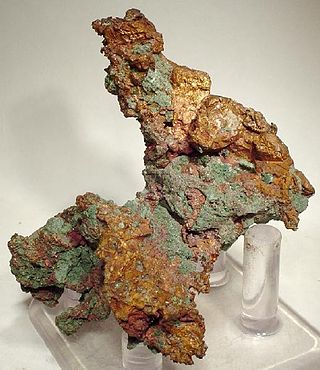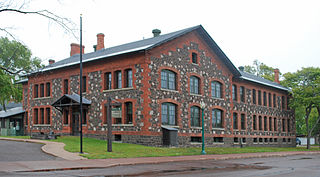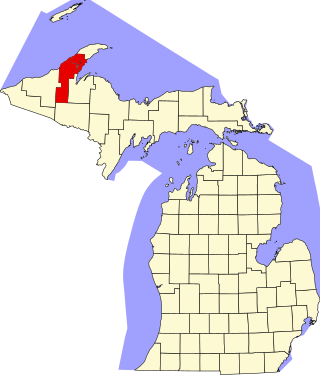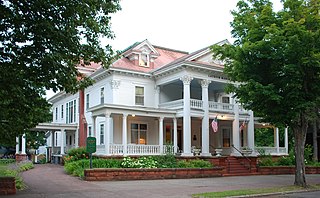
Hancock is a city in the Upper Peninsula of the U.S. state of Michigan. The population of Hancock was 4,501 at the 2020 census. The city is located within Houghton County, and is situated upon the Keweenaw Waterway, a channel of Lake Superior that cuts across the Keweenaw Peninsula. Hancock is located across the Keweenaw Waterway from the city of Houghton, and is connected to that city by the Portage Lake Lift Bridge. The city is located within Michigan's Copper Country region.

Calumet is a village in the Upper Peninsula of the U.S. state of Michigan. The village is located within Calumet Township, Houghton County, and had a population of 621 at the 2020 census.

Ahmeek is a village in Keweenaw County in the U.S. state of Michigan. The village is located within Allouez Township. The population was 127 at the 2020 census.

The Minesota Mine is a former copper mine near Rockland, Ontonagon County in the Upper Peninsula of the U.S. state of Michigan. The Minesota was one of the most productive and famous early mines in the Michigan Copper Country.

Keweenaw National Historical Park is a unit of the U.S. National Park Service. Established in 1992, the park celebrates the life and history of the Keweenaw Peninsula in the Upper Peninsula of the U.S. state of Michigan. As of 2009, it is a partly privatized park made up of two primary units, the Calumet Unit and the Quincy Unit, and 21 cooperating "Heritage Sites" located on federal, state, and privately owned land in and around the Keweenaw Peninsula. The National Park Service owns approximately 1,700 acres (690 ha) in the Calumet and Quincy Units. Units are located in Baraga, Houghton, Keweenaw, and Ontonagon counties.

This is a list of the National Register of Historic Places listings in Houghton County, Michigan.

The Calumet and Hecla Mining Company was a major copper-mining company based within Michigan's Copper Country. In the 19th century, the company paid out more than $72 million in shareholder dividends, more than any other mining company in the United States during that period.

In Michigan, copper mining became an important industry in the 19th and early 20th centuries. Its rise marked the start of copper mining as a major industry in the United States.
The Copper Country strike of 1913–1914 was a major strike affecting all copper mines in the Copper Country of Michigan. The strike, organized by the Western Federation of Miners, was the first unionized strike within the Copper Country. It was called to achieve goals of shorter work days, higher wages, union recognition, and to maintain family mining groups. The strike lasted just over nine months, including the Italian Hall disaster on Christmas Eve, and ended with the union being effectively driven out of the Keweenaw Peninsula. While unsuccessful, the strike is considered a turning point in the history of the Copper Country.

The Calumet Historic District is a National Historic Landmark District that encompasses most of the village of Calumet, Michigan. The district was designated in 1989 for the community's importance in the history of the region's copper mining industry.

The Thomas H. Hoatson House is a house located at 320 Tamarack Street in Laurium, Michigan. It was listed on the National Register of Historic Places in 1994. At 13,000 square feet (1,200 m2), it is the largest mansion in the western Upper Peninsula of Michigan.

The Calumet and Hecla Industrial District is a historic district located in Calumet, Michigan and roughly bounded by Hecla & Torch Lake Railroad tracks, Calumet Avenue, Mine and Depot Streets. The district contains structures associated with the copper mines worked by the Calumet and Hecla Mining Company, located along a line above the copper lode, where railroad tracks connected separate mine heads. The Historic District is completely contained in the Calumet Historic District and the Keweenaw National Historical Park. It was designated a Michigan State Historic Site in 1973 and was listed on the National Register of Historic Places in 1974.

The Quincy Mine No. 2 Shaft Hoist House is an industrial building located north of Hancock, Michigan along US Highway 41 within the Quincy Mining Company Historic District. The Hoist House contains the largest steam hoisting engine in the world, which sits on the largest reinforced concrete engine foundation ever poured. The shaft hoist house was designated a Michigan State Historic Site in 1969 and listed on the National Register of Historic Places in 1970.

The Quincy Mining Company Stamp Mills Historic District is a historic stamp mill located on M-26 near Torch Lake, just east of Mason in Osceola Township. It was listed on the National Register of Historic Places in 2007.

The Quincy Dredge Number Two is a dredge currently sunk in shallow water in Torch Lake, across M-26 from the Quincy Mining Company Stamp Mills Historic District and just east of Mason in Osceola Township. It was constructed to reclaim stamping sand from the lake for further processing, and was designated a Michigan State Historic Site in 1978.

The Quincy Smelter, also known as the Quincy Smelting Works, is a former copper smelter located on the north side of the Keweenaw Waterway in Ripley, Michigan. It is a contributing property of the Quincy Mining Company Historic District, a National Historic Landmark District. The smelter was built in 1898 by the Quincy Mining Company, operating from 1898 to 1931 and again from 1948 to 1971. The smelter was part of a Superfund site from 1986 to 2013.
The Osceola Mine was a copper mine consisting of 11 shafts located in Osceola Township, Houghton County, Michigan. In 1895, it was the site of the deadliest mine disaster in the Copper Country.
The Quincy & Torch Lake Railroad (Q&TL), an affiliate of the Quincy Mining Company, was a 3-foot-gauge shortline railroad located at Hancock in the Upper Peninsula of Michigan, not far from Torch Lake. It was created to replace an existing tramway, and was designed to take copper-bearing rock from the Quincy Mine downhill to a mill, and return coal uphill to power mine operations. The mainline was just six and a half miles in length, while sidings and extensions added about 8 miles, for total trackage under 15 miles.

























